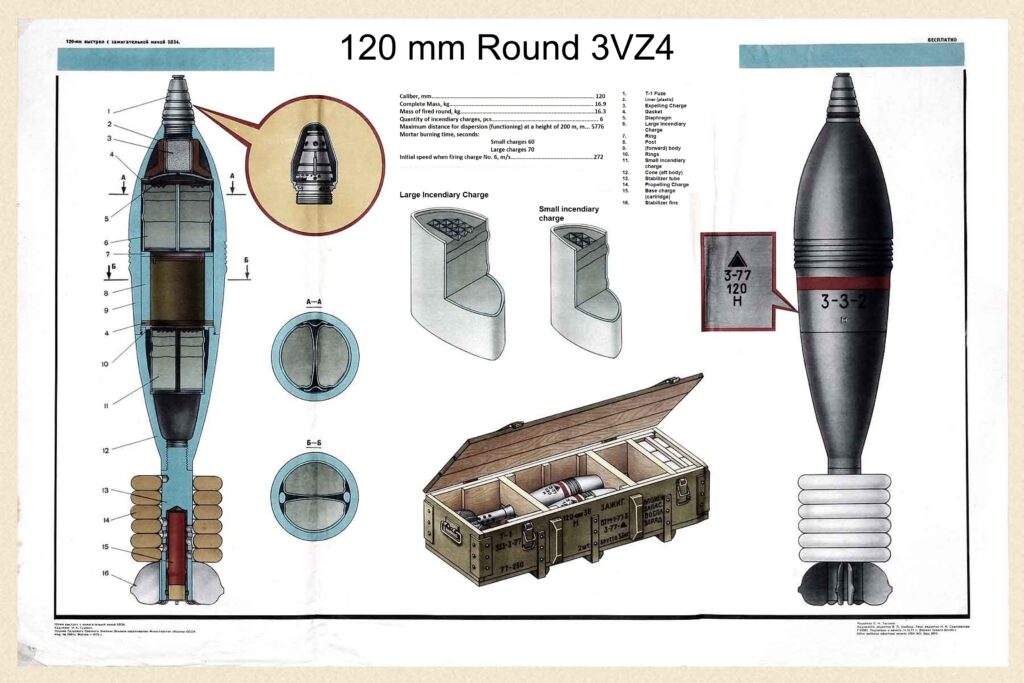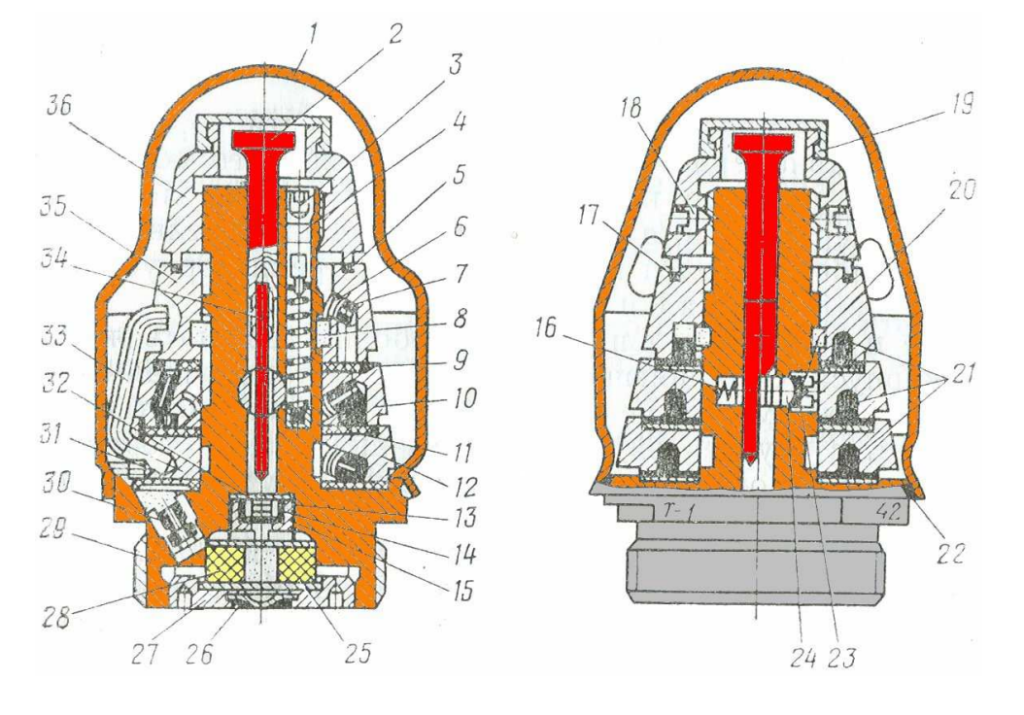Tony Salvo & N.R. Jenzen-Jones
An image shared by the State Emergency Service of Ukraine (DSNS) via social media in early May depicts what appear to be several Soviet 3-Z-2 (sometimes written ‘3Z2’) 120 mm incendiary mortar projectiles near the city of Mykolaiv, in southern Ukraine (see Figure 1). The items pictured display evidence of black soot marks, rust, and the peeling of paint, which may indicate that they were recovered from an area that had experienced a fire. Fuzes appear to be entirely absent from the projectiles, although it is possible these were removed by DSNS explosive ordnance disposal (EOD) teams. Visible markings on some of the projectiles indicate they were produced in 1985 (see Figure 4). Russian forces have deployed a variety of incendiary weapons to Ukraine during the recent hostilities, including the 9M22S 122 mm incendiary artillery rocket, and shoulder-fired rocket launchers and recoilless weapons such as the RPO-A, MRO-A, RShG-2, and RPV-16. Ukraine is also believed to hold Soviet-era incendiary weapons in its stockpiles.

The 120 mm 3-Z-2 incendiary mortar projectile contains 6 incendiary elements, four large and two small (see Figure 2). These are hollow steel ‘cups’ filled with an incendiary mixture of an unknown type, but likely comparable in effect to thermite and similar compositions. When the fuze functions, either following a pre-set time delay or upon impact with the ground, it initiates an expelling charge. The gases produced by the expelling charge both ignite the incendiary elements and overcome the connecting threads between the fore and aft portions of the projectile body. The incendiary elements are ejected from the rear (or base) of the mortar and dispersed along the round’s flight trajectory. The small charges burn for approximately 60 seconds, whilst the larger charges burn for approximately 70 seconds.

When combined with the T-1 fuze, one or more propellant charges, and an ignition cartridge (e.g., the 54-Zh-843 charge system) the entire round is designated the 3VZ4 (the ‘V’ standing for vystrel, or ‘round’). Note that, due to the similarity of the numeral ‘3’ and the Cyrillic letter ‘З’ (‘Z’), there is sometimes confusion as to the designation of this round—even in Russian sources. The T-1 fuze (see Figure 3) is described in some U.S. government ordnance documents as a powder-train time fuze (PTTF) with impact backup, but has more recently been referred to as a ‘time superquick’ (TSQ) type. Soviet sources describe the fuze as a ‘pyrotechnic remote–impact fuze’ (‘remote action’, distantsionnoye deystviye, referring to time fuzes). These nuances in nomenclature come about as the T-1 features, in addition to a standard powder-train timing mechanism, a selectable impact-mode and backup impact fuzing feature. Ordinarily, the impact feature will function if the munition strikes the target before the expiration of the pyrotechnic timer setting (e.g., if the timing feature was incorrectly set or fails to operate as intended), however it can also be proactively selected prior to firing. When the impact-only mode (marked on the time ring as “УД” for udarnoye deystviye, or ‘impact action’) of the T-1 fuze is selected, the projectile will detonate upon striking a hard surface, rather than functioning in the air. This will result in a much more localised dispersion of the incendiary elements, which may be advantageous in scenarios such as the targeting of specific equipment, vehicles, or a fuel depot. An airburst functioning will result in a wider dispersion of the incendiary elements, more suitable to setting fire to wider area targets, such as distributed fuel or ammunition storage facilities, forests, or agricultural land.

The 3-Z-2 mortar projectile can be identified by its distinctive physical features (body and incendiary element remnants) and markings (including designation and red-coloured band). It is distinguishable in form and markings from the earlier Z-843А 120 mm incendiary mortar projectile. The ejection of six incendiary elements may also result in a distinctive visual signature when the munition functions. This will be particularly obvious at night, although ARES has not yet observed this in the many night-time videos shared via social media. Nonetheless, examples of the use of the 3-Z-2 120 mm incendiary mortar projectile in Ukraine may yet come to light.
With thanks to Neil Gibson and Jake Godin.
Sources
ARES (Armament Research Services). n.d. Conflict Materiel (CONMAT) Database. Confidential. Perth: ARES.
Jenzen-Jones, N.R. 2022. ‘Soviet or Russian 9M22S incendiary rockets documented in Ukraine (2022)’. The Hoplite. 19 April. <https://armamentresearch.com/soviet-or-russian-9m22s-incendiary-rockets-documented-in-ukraine-2022/>.
Jenzen-Jones, N.R. and S. Paunila. 2018. Explosive Weapon Effects: Final Report. Geneva: Geneva International Centre for Humanitarian Demining (GICHD). <http://characterisationexplosiveweapons.org/studies/final-report/>.
Kochergin, Anatoly et al. 2022. Химия и боеприпасы артиллерии. Учебник для вузов [‘Chemistry and Artillery Ammunition: A Textbook for Universities’]. Moscow: Yurayt.
Ministry of Defence of the USSR. 1957a. 120-мм миномет обр. 1938 г. Руководство службы [‘120 mm Mortar Model of 1938: Service Manual’]. Moscow: Ministry of Defence of the USSR.
Ministry of Defence of the USSR. 1957b. Пиротехническая дистанционно-ударная трубка т-1. Руководство службы [‘Pyrotechnic Remote–Shock Tube T-1: Service Manual’]. Moscow: Ministry of Defence of the USSR.
Ministry of Defence of the USSR. 1990a. 120-мм Возимый миномет 2С12 – Техническое описание и инструкция по эксплуатации ч.2 боеприпасы [‘120 mm Mobile Mortar 2S12: Technical Description and Operating Instructions, Part 2: Ammunition’]. Moscow: Ministry of Defence of the USSR.
Ministry of Defence of the USSR. 1990b. 82-мм миномет 2Б14-1 – Техническое описание и инструкция по эксплуатации [’82 mm Mortar 2B14-1: Technical Description and Operating Instructions’]. Moscow: Ministry of Defence of the USSR.
National Ground Intelligence Center. 1997. Worldwide Fuze Identification Guide. Defense Intelligence Reference Document, NGIC-1143-029-98. Charlottesville: NGIC.
U.S. Army Foreign Science and Technology Center. 1973. Fuze Manual: Eurasian Communist Countries. FSTC-CW-07-100-73. Charlottesville: U.S. Army Materiel Command.
Remember, all arms and munitions are dangerous. Treat all firearms as if they are loaded, and all munitions as if they are live, until you have personally confirmed otherwise. If you do not have specialist knowledge, never assume that arms or munitions are safe to handle until they have been inspected by a subject matter specialist. You should not approach, handle, move, operate, or modify arms and munitions unless explicitly trained to do so. If you encounter any unexploded ordnance (UXO) or explosive remnants of war (ERW), always remember the ‘ARMS’ acronym:
AVOID the area
RECORD all relevant information
MARK the area from a safe distance to warn others
SEEK assistance from the relevant authorities




